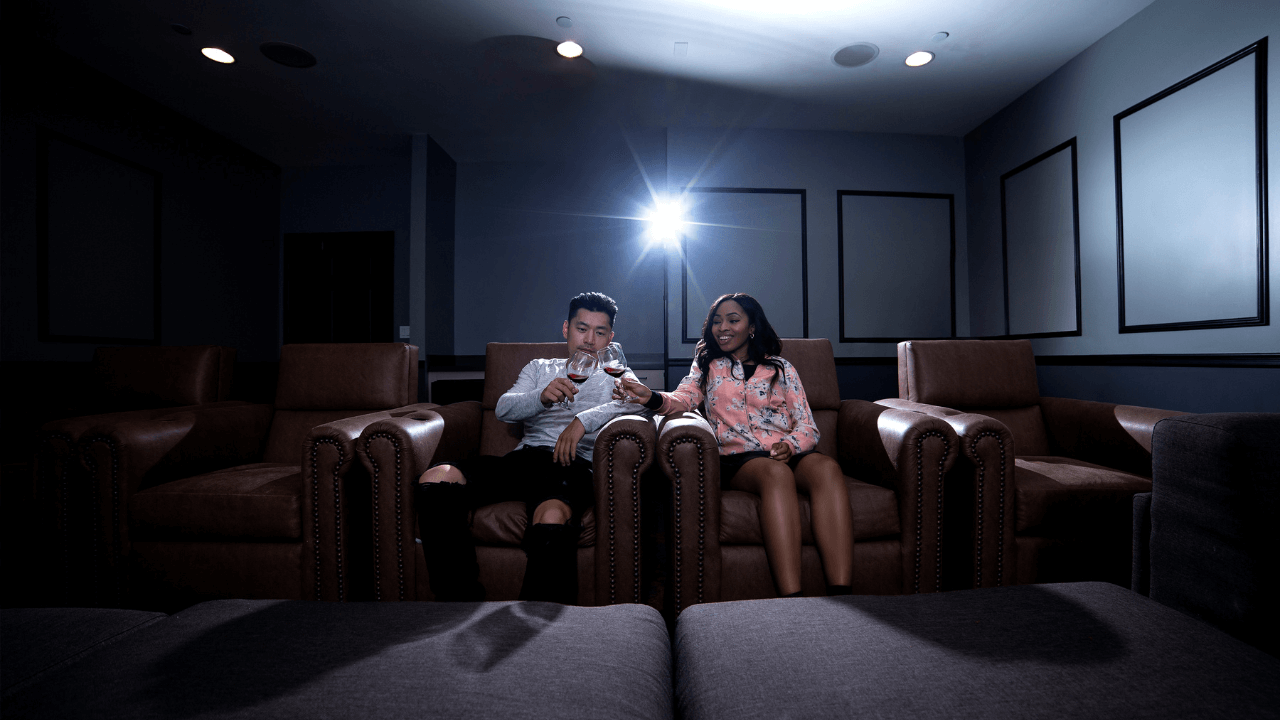Few people could imagine watching a movie today without sound. An improved audio experience brings the viewer more fully into the story that’s being told in front of them. Audio immerses us in the story, enhancing our feelings of amazement, excitement, and even fear.
Since the advent of synchronized sound on film technology in the 1920s, people have been craving enhanced audio experiences with their visual entertainment. Once silent films gave way to “talkies” there was no going back, and audio technology has been moving forward ever since.
Audio Technology in Cinema
“The Jazz Singer” (released in 1927) is widely regarded as the first feature length film to incorporate fully synchronized audio for both dialogue and music – the first talking picture. The era of silent films ended rather abruptly after its release, and further audio technology innovations followed.
While most of us take stereo for granted today, in 1940, Disney’s “Fantasia” became the first film shown commercially in that format: two audio channels, left and right; a contrast to the mono soundtracks that came before it. This brought a richness and depth to the classical film score that had never been heard before by a mass audience.
The post-WWII era brought advancements in sound recording technology such as magnetic tape and multitrack recording. The 1950s saw the birth of television, and the first time there was a real tension between in-home entertainment and the theatre. Hollywood countered TV with innovations like widescreen cinema — notably Cinerama and Cinemascope — which featured a huge, immersive curved screen and enhanced audio, leveraging a 7-track magnetic audio tape and one of the earliest appearances of what we now refer to as “surround sound” with directional speakers in the auditorium. This innovation bathed audiences in a combination of rich audiovisual entertainment.
The mid-1970s saw the birth of digital recording technology, which brought greater flexibility to audio engineers and paved the way for surround sound, digital signal processing and a wide range of special audio effects. Audiences at that time had no idea that one day these thrilling cinematic experiences would be possible in their own homes.
Music: Enhancing the Experience
We are no doubt all familiar with the iconic theme from the 1975 thriller “Jaws.” The ominous, pulsing music suggests imminent danger, and has become closely associated with an impending attack. As suspenseful as John Williams’ soundtrack was, what many don’t know is that the music was used by the filmmakers in part to cover up for the fact that the enormous animatronic shark designed for the production was prone to frequent malfunctions. As such, this “shark” itself only appears a few times in the film. Most other “appearances” of the shark in the film are merely suggested by the music, so powerful was the score.
The soundtrack of “Jaws” (and certainly many other films) transports us to places in our minds and emotional states that wouldn’t happen otherwise. Williams’ score, and the deliberate way in which it was used in the film, evokes fear in the audience, arguably more so than the visual of an animatronic model shark would have. The soundtrack helps guide our imagination toward what many of us view as the most horrific animal encounter imaginable.
In order for the soundtrack to have this effect, however, it had to be reproduced in the theatre in a way that we were immersed in the experience. This kind of immersion would not have been possible in an earlier era.
Sculpting the Soundscape and the Advent of Digital Audio
George Lucas, creator of the 1977 blockbuster “Star Wars” franchise, famously said, “sound is 50 percent of the movie going experience, and I’ve always believed audiences are moved and excited by what they hear in my movies at least as much as by what they see.”
We can think about other now-classic films that have awed us with their use of music and sound. The entire “Star Wars” franchise is known for its soundscapes, from John Williams’ sweeping and now-iconic musical score, to the deep rumbling of Imperial Starships and whines of the Tie Fighters, to the high-pitched beeps of R2D2 and countless other droids.
“Jurassic Park,” released in 1993, was the first film ever to incorporate a fully digital sound track. Director Steven Spielberg believed that digital sound was the best way to create the now-iconic sound environment that the film needed, and he funded the creation of DTS (now owned by Xperi) in order to help realize this vision. John Williams contributed another now-legendary musical score to the film, and the franchise has now spawned five additional films, several video games, theme park rides and countless toys and merchandise, grossing several billion dollars worldwide.
The absence of sound has been used to dramatic effect as well. Notably the 2018 horror film “A Quiet Place” is a story that revolves entirely around the absence (or near-absence) of sound as a central plot device.
The Living Room – A Miniature Cinema?
Improved audio experiences are a major driver in the improvement of home entertainment today. Whether you’re watching a movie, a favorite TV show, or playing the latest video game, audio quality is a primary consideration. An amazing home theatre experience now involves having speakers in front of you, behind you, above and even below you, to a point where you feel like you are part of the action. The audio experience transports us somewhere outside of our living room into another place. We no longer need to leave our homes to have a cinema-quality experience.
A great audio experience in the home theatre is dependent upon — among other things — a number of different approaches to device miniaturization. The speakers in a large cinema are huge. From quiet dialogue to bone-jarring special effects, those sound systems are capable of dynamically reproducing a wide range of sounds in those large with a high degree of intensity. In the home theatre, everything necessarily exists on a smaller scale than the commercial cinema: the room is smaller, the screen is smaller, and so must be the speakers.
One triumph of home theatre technology is largely the way in which those cinematic experiences have now been brought into our living rooms. A home theatre speaker might not be much larger than a coffee mug (while a center channel speaker in a commercial cinema might be the size of a refrigerator), but this small speaker produces high-fidelity, immersive quality sound at volumes appropriate for our homes.
The subwoofer behind our couch can make the floor rumble as the T-Rex approaches in “Jurassic Park.” The front, rear and side speakers make it sound as if Imperial Tie Fighters are flying through our living room. The melancholic score of “Titanic” can bring tears to our eyes. The home audio systems of today give us a sense of action, space and emotion in a way that transports us into the environment of the content we are watching. Their compact speakers are capable of outstanding audio resolution, so we can hear a wide range of audio frequencies from rumbling lows to piercing highs. Dialogue is crisp and intelligible, while music and sound effects are rich and dynamic.
Getting Started
Nowadays there is more demand than ever from consumers seeking cinema-quality experiences at home. The Covid-19 pandemic accelerated some of this demand, as most movie watching necessarily moved into the home. As technology continues to improve, we will see more people setting up these kinds of personalized systems, tailored to their own homes and budgets and viewing habits. Some people may find a simple soundbar is sufficient, while others will spend thousands of dollars setting up an immersive multi-channel wireless surround sound system that rivals that of an IMAX cinema in many respects.
In addition to their compact size, flexibility and excellent audio quality, these systems are simple and intuitive to set up. While cinemas often have to hire expensive consultants to fine-tune their audio systems, consumers can take their home theatre systems out of the box, and have them set up and sounding great within minutes. The technology has never been more approachable or affordable.
Stay up to date on the latest technology and insights from DTS here.



